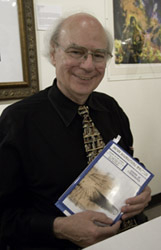John Lienhard, M.D. Anderson Professor of Technology and Culture, Emeritus with the University of Houston Cullen College of Engineering, has provided rare textbooks from his private collection for a public exhibition entitled “Ghosts in the Books: Echoes of Old Voices from the Books that Made America.”
The exhibit is being held at Houston’s Museum of Printing History, and will run from June 22 to October 19. It narrates Lienhard’s encounters with a selection of 19th century textbooks and the lives of their former owners through the owner’s notes in the books.
“These books make history real, you can see it through their owner’s eyes and have this sense of being there,” said Lienhard.
They also serve as examples of how inexpensive and widespread printing changed the ways in which our country taught itself, leading to the establishment of America as a technological force. Through these books Americans taught themselves such fields as chemistry, astronomy, geography and biology, said Lienhard.
“The books are the fruit of the new fast presses. If you look during the time of these books, you’ll find that America didn’t have access to universities and schools and people learned by reading and made scientists of themselves by reading them,” he said.
Among the textbooks featured in the exhibit are some by Jane Haldimand Marcet, author of several popular 19th century texts written in a conversational form. For example, a lesson Marcet wrote on heat radiation features a chat between a fictitious tutor, Mrs. B, and her pupils, Caroline and Emily. Readers eavesdrop as the trio conducts an experiment involving a tin canister filled with hot water and learn that the can’s color and texture affect heat.
One of Marcet’s books on display, Conversations on Natural Philosophy (1834), was owned by Texas farmer Joseph Whittenburg, who originally dated the book May 13, 1838. Whittenburg went on to write several more dates in the book, suggesting that he went back to it several times.
Notes such as these enable history to be seen not only through the books themselves and the historical significance of their publishing, but also allow a glimpse into the history and lives of their owners.
“You get a sense of contact with the past, that’s what we’re really trying to accomplish with this particular exhibit,” said Lienhard.
